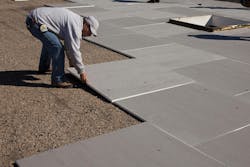Polyiso and Mineral Fiber Insulation in Green Roofs
When it comes to insulation boards for vegetated roofs, there are several choices available but polyisocyanurate (also known as polyiso) continues to lead the way, according to the 2015-16 market survey by the National Roofing Contractors Association (NRCA).[1] When compared to mineral fiber insulation, polyiso may carry a higher cost but is overall a higher-performing thermal insulator material.
To achieve the recommended roof insulation for most of the continental United States, builders would need to install more inches of mineral fiber boards versus polyiso, which has a higher R-value (capacity of a material’s thermal resistance) per inch of thickness than the former. In practical terms, it may also mean ordering more than necessary because mineral fiber is sold in 1-inch thicknesses while half-inch thicknesses are also available for polyiso.
Polyiso also weighs roughly 90 percent less than mineral fiber boards, which typically weigh about 1.04 psf (pounds per square foot) for each inch of thickness; polyiso weighs 0.166 psf for each inch of thickness. This weight difference also makes polyiso faster and easier to install. For those designing the vegetated roof, the extra dead load of mineral fiber can increase costs for structural elements overall in the roof, the walls or columns supporting it, and the foundation. In new construction, or if the existing roof needs structural reinforcement for installing a vegetated roof, the lower dead load of polyiso could help the cost differential between the two insulation materials.
Polyiso has very low water absorption because it is a closed-cell foam, while mineral fiber is a porous material and susceptible to water absorption. This may be very significant on a vegetated roof, where water is always present. If membrane penetration results in a leak, mineral fiber insulation can absorb the water, adding to the weight of the roof and providing an environment for mold or bacterial growth.
Polyiso also has considerably higher compressive strength than mineral fiber. At 20 psi vs 11 psi, polyiso is about 80 percent stronger, and therefore much less susceptible to compression. If an insulating board gets compressed, its insulation value can be reduced. Moreover, if it gets compressed (for instance, by foot traffic during construction) in an area around a fastener, it can leave the head of the fastener protruding and cause a membrane penetration that can leak.
However, insulation materials respond differently at various temperatures. R-value is measured at 75ºF, but actual performance varies at other temperatures. Mineral fiber is at its best in the cold, and at its worst in the heat. It measures about R-4.4/inch at 20ºF, but decreases continuously to about R-3.8 at 90ºF. On the other hand, polyiso has a curved temperature response graph. It measures about R-5.6/inch at 20ºF, rises to peak at R-6 in the range between 50ºF and 60ºF, and then decreases to about R-5.3 at 90ºF. In extremely low temperatures (below 0ºF) the insulating value of polyiso decreases considerably, so there may be additional considerations for areas where negative-degree temperatures are a frequent occurrence.
As a high-performing thermal insulator, polyiso has risen as an ideal choice for sustainable building designs, and it can contribute to several LEED prerequisites and credits in the Energy and Atmosphere (EA) and Materials and Resources (MR) categories. When used as the insulation board for vegetative roofs, the combination can serve to greatly benefit building teams in pursuit of sustainability initiatives, particularly for their roofing systems. Polyiso currently leads its sector of the overall roofing market, comprising 80 percent of new construction and 73% of reroofing work[1], and is sure to continue making waves in the years to come.
References
1 http://fmlink.com/articles/nrca-2016-market-survey-roofing-industry-remains-strong/
